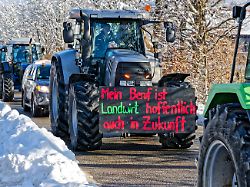Current data on farm death
Large companies grow, the small ones disappear
January 23, 2024, 6:19 p.m
Listen to article
This audio version was artificially generated. More info | Send feedback
Far-reaching change in German agriculture: 7,800 businesses give up within three years. Small farms in particular are affected, while large farms gain more agricultural land.
The death of farms in German agriculture continues. 7,800 farmers gave up their businesses between 2020 and 2023, according to the Federal Statistical Office. Small and medium-sized farms are particularly affected. Their land is often taken over by larger agricultural companies.
The official data shows that the trend of the past decades is continuing: the total German cultivated area was 16.6 million hectares in 2022. It has hardly changed in the last twelve years. However, the proportion of large companies rose from 55 to 62 percent in the same period. This corresponds to an increase of almost 1.2 million hectares. The ownership of small and medium-sized businesses, however, has shrunk by 1.3 million hectares. The average cultivated area per farm increased from 56 to 65 hectares.
The trend is also reflected in the farm structure: from 2010 to 2022, the number of small and medium-sized farms with up to 100 hectares of cultivated land has shrunk by 45,590. The smallest farms with less than five hectares seem to have a particularly difficult time: 28 percent of the farms disappeared here.
Observers see demographic change as one of the reasons for the changes. “The baby boomers are reaching an age where they need successors,” reported the radio journalist and agricultural expert, for example Ann-Kathrin Büüsker. Finding a successor is becoming increasingly difficult. “Who wants to take a job that is not profitable, that is highly dependent on the state and that enjoys little recognition?”
According to Büüsker, the beneficiaries are large companies and agricultural holding companies. In a twelve-year comparison, the number of farms with more than 100 hectares rose by 5,130, according to the Federal Statistical Office. EU subsidies are also fueling this development.
Since the funding is linked to the area under cultivation, the larger companies benefit most from the money from Brussels. “When small farms give up, they buy up the land and can thereby increase the amount of subsidies they receive,” says agricultural journalist Büüsker, summarizing the development. “Because of their size, their economic strength and their good network, they are able to prevent reforms.”
